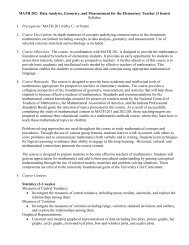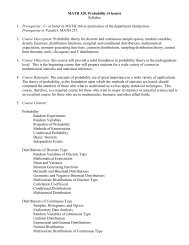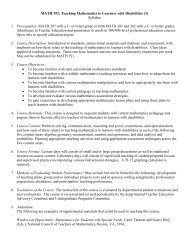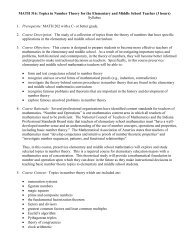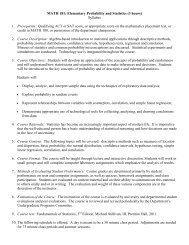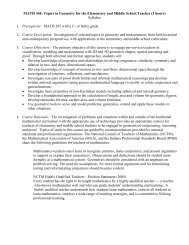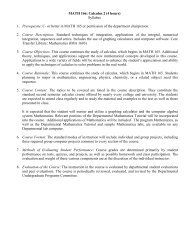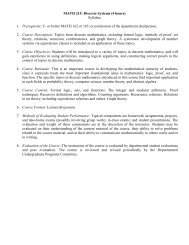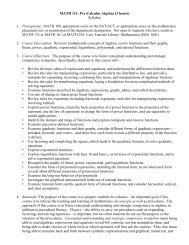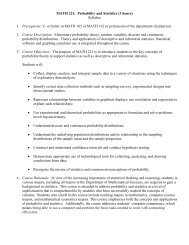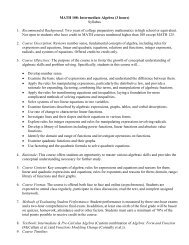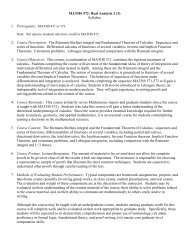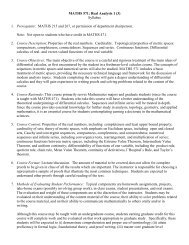Teaching and Learning Mathematics in the Secondary School
Teaching and Learning Mathematics in the Secondary School
Teaching and Learning Mathematics in the Secondary School
Create successful ePaper yourself
Turn your PDF publications into a flip-book with our unique Google optimized e-Paper software.
MATH 395: <strong>Teach<strong>in</strong>g</strong> <strong>and</strong> <strong>Learn<strong>in</strong>g</strong> <strong>Ma<strong>the</strong>matics</strong> <strong>in</strong> <strong>the</strong> <strong>Secondary</strong> <strong>School</strong> (3)<br />
Syllabus<br />
1. Prerequisite: C- or better <strong>in</strong> MATH 250, <strong>and</strong> MATH 311 or MATH 310, <strong>and</strong> MATH 345 or MATH<br />
360, <strong>and</strong> MATH 393; a m<strong>in</strong>imum grade-po<strong>in</strong>t average of 2.5 <strong>in</strong> all ma<strong>the</strong>matics courses that are to be<br />
applied to <strong>the</strong> major, <strong>and</strong> admittance to teacher education <strong>and</strong> permission to enroll <strong>in</strong> 300/400 level<br />
professional education courses.<br />
2. Parallel: EDJH 385 <strong>and</strong> EDSE 380.<br />
3. Course Description: Exam<strong>in</strong>ation of national <strong>and</strong> state ma<strong>the</strong>matics st<strong>and</strong>ards, curricular materials, <strong>and</strong><br />
methods for teach<strong>in</strong>g ma<strong>the</strong>matics to secondary school students. Issues related to ma<strong>the</strong>matics<br />
curriculum, <strong>in</strong>struction, <strong>and</strong> assessment of secondary school students. Class ideas applied <strong>in</strong> teach<strong>in</strong>g<br />
situations.<br />
4. Course Objectives: The primary objective of this course is to <strong>in</strong>troduce preservice teachers to <strong>the</strong><br />
methods, materials, <strong>and</strong> issues related to teach<strong>in</strong>g ma<strong>the</strong>matics <strong>in</strong> <strong>the</strong> secondary school. Ano<strong>the</strong>r<br />
objective is to help <strong>the</strong>se students underst<strong>and</strong> <strong>the</strong> multiple professional responsibilities of a teacher of<br />
ma<strong>the</strong>matics by <strong>in</strong>volv<strong>in</strong>g <strong>the</strong>m <strong>in</strong> direct classroom teach<strong>in</strong>g experiences. Students will be able to:<br />
<br />
<br />
<br />
<br />
<br />
<br />
<br />
<br />
<br />
<br />
<br />
<br />
<br />
<br />
<br />
Use national <strong>and</strong> state st<strong>and</strong>ards to guide curricular, <strong>in</strong>structional, <strong>and</strong> assessment decisions.<br />
Use contemporary learn<strong>in</strong>g <strong>the</strong>ories, related to ma<strong>the</strong>matics education, to make curricular,<br />
<strong>in</strong>structional, <strong>and</strong> assessment decisions.<br />
Analyze curriculum materials appropriate for use <strong>in</strong> <strong>the</strong> secondary school ma<strong>the</strong>matics classroom.<br />
Determ<strong>in</strong>e <strong>the</strong> appropriate use of student curriculum materials <strong>and</strong> teachers’ editions of secondary<br />
school textbooks to teach specific ma<strong>the</strong>matical topics.<br />
Determ<strong>in</strong>e <strong>the</strong> appropriate use of physical, pictorial, <strong>and</strong> abstract models to teach specific<br />
ma<strong>the</strong>matical concepts.<br />
Determ<strong>in</strong>e <strong>the</strong> appropriate use of technological tools, <strong>in</strong>clud<strong>in</strong>g software, to teach specific<br />
ma<strong>the</strong>matical concepts.<br />
Utilize supplemental resource materials <strong>in</strong> plann<strong>in</strong>g for secondary school ma<strong>the</strong>matics <strong>in</strong>struction.<br />
Determ<strong>in</strong>e <strong>the</strong> appropriate use of various <strong>in</strong>structional formats for effective ma<strong>the</strong>matics <strong>in</strong>struction.<br />
Write ma<strong>the</strong>matics lesson plans for selected topics <strong>in</strong> <strong>the</strong> secondary school ma<strong>the</strong>matics curriculum.<br />
Recognize various practical applications of topics found <strong>in</strong> <strong>the</strong> secondary school ma<strong>the</strong>matics<br />
curriculum.<br />
Identify ways <strong>in</strong> which lessons can be adapted for students with special needs.<br />
Implement lesson plans by teach<strong>in</strong>g peers or secondary school students.<br />
Reflect on <strong>the</strong>ir experiences <strong>in</strong> plann<strong>in</strong>g <strong>and</strong> teach<strong>in</strong>g ma<strong>the</strong>matics lessons.<br />
Determ<strong>in</strong>e appropriate assessment tasks <strong>and</strong> activities for specific ma<strong>the</strong>matical topics <strong>in</strong> <strong>the</strong><br />
secondary school curriculum.<br />
Ref<strong>in</strong>e <strong>and</strong> present <strong>the</strong>ir personal philosophy of ma<strong>the</strong>matics education.<br />
5. Decision Po<strong>in</strong>t 3: Portfolio Requirements for Decision Po<strong>in</strong>t 3 will be evaluated for evidence of<br />
successful progress <strong>in</strong> ma<strong>the</strong>matics content knowledge, pedagogical content knowledge, technology<br />
knowledge <strong>and</strong> skills, <strong>and</strong> communication skills.<br />
6. Course Rationale: This course serves as <strong>the</strong> culm<strong>in</strong>at<strong>in</strong>g professional experience for<br />
preservice secondary ma<strong>the</strong>matics teachers prior to <strong>the</strong>ir immersion <strong>in</strong> student teach<strong>in</strong>g. It provides<br />
appropriate opportunities for <strong>the</strong>m to utilize <strong>the</strong> knowledge acquired <strong>in</strong> prior ma<strong>the</strong>matics <strong>and</strong><br />
ma<strong>the</strong>matics education courses <strong>and</strong> to apply this knowledge <strong>in</strong> practical situations related to teach<strong>in</strong>g<br />
secondary school ma<strong>the</strong>matics. At <strong>the</strong> conclusion of <strong>the</strong> course, students should have an <strong>in</strong>formed
vision of ma<strong>the</strong>matics <strong>and</strong> ma<strong>the</strong>matics teach<strong>in</strong>g that will enable <strong>the</strong>m to move confidently <strong>in</strong>to student<br />
teach<strong>in</strong>g, obta<strong>in</strong> licensure, <strong>and</strong> enjoy successful professional careers.<br />
7. Course Content:<br />
St<strong>and</strong>ards for <strong>Teach<strong>in</strong>g</strong> <strong>Secondary</strong> <strong>School</strong> <strong>Ma<strong>the</strong>matics</strong><br />
In-depth analysis of Pr<strong>in</strong>ciples <strong>and</strong> St<strong>and</strong>ards for <strong>School</strong> <strong>Ma<strong>the</strong>matics</strong> (2000) published by <strong>the</strong><br />
National Council of Teachers of <strong>Ma<strong>the</strong>matics</strong> (grades 9-12).<br />
In-depth analysis of Indiana Academic St<strong>and</strong>ards for <strong>Ma<strong>the</strong>matics</strong> (2000) published by <strong>the</strong> Indiana<br />
Department of Education (grades 9-12).<br />
Discussion, as appropriate, of evolv<strong>in</strong>g national <strong>and</strong> <strong>in</strong>ternational st<strong>and</strong>ards related to ma<strong>the</strong>matics<br />
from a historical perspective.<br />
Discussion of <strong>the</strong> role of <strong>the</strong> teacher as a professional <strong>and</strong> of <strong>the</strong> importance of <strong>in</strong>volvement <strong>in</strong><br />
professional organizations (e.g., NCTM, ICTM).<br />
Curriculum Materials<br />
Analysis <strong>and</strong> comparison of traditional <strong>and</strong> contemporary ma<strong>the</strong>matics curriculum materials for<br />
grades 9-12.<br />
Exam<strong>in</strong>ation of various supplemental materials for teach<strong>in</strong>g secondary ma<strong>the</strong>matics.<br />
Instructional Methods <strong>and</strong> Materials<br />
Discussion, based on selected read<strong>in</strong>gs, of topics such as alternative views <strong>and</strong> <strong>the</strong>ories of learn<strong>in</strong>g,<br />
motivation, <strong>in</strong>structional methods, <strong>and</strong> classroom management skills.<br />
Analysis <strong>and</strong> discussion of various physical, pictorial, <strong>and</strong> abstract models appropriate for use <strong>in</strong><br />
secondary ma<strong>the</strong>matics classrooms.<br />
Analysis <strong>and</strong> discussion of technological tools useful for teach<strong>in</strong>g topics <strong>in</strong> <strong>the</strong> secondary<br />
ma<strong>the</strong>matics curriculum.<br />
Discussion of procedures <strong>and</strong> techniques for adapt<strong>in</strong>g lessons for students with special needs.<br />
Assessment<br />
Discussion of <strong>the</strong> assessment process (e.g., sett<strong>in</strong>g goals <strong>and</strong> plann<strong>in</strong>g, ga<strong>the</strong>r<strong>in</strong>g evidence us<strong>in</strong>g<br />
multiple methods, <strong>in</strong>terpret<strong>in</strong>g evidence <strong>and</strong> mak<strong>in</strong>g <strong>in</strong>ferences, mak<strong>in</strong>g decisions <strong>and</strong> tak<strong>in</strong>g action).<br />
Discussion of both formative <strong>and</strong> summative assessment.<br />
Analysis of <strong>the</strong> role of external assessments (e.g., st<strong>and</strong>ardized tests, advanced placement exams)<br />
Analysis of performance tasks <strong>and</strong> scor<strong>in</strong>g rubrics.<br />
Observations <strong>and</strong> <strong>Teach<strong>in</strong>g</strong><br />
Formal observations of experienced secondary ma<strong>the</strong>matics teachers at various levels <strong>and</strong> <strong>in</strong><br />
different classroom sett<strong>in</strong>gs.<br />
Discussion <strong>and</strong> detailed writ<strong>in</strong>g of lesson plans.<br />
Supervised teach<strong>in</strong>g of students <strong>in</strong> selected sett<strong>in</strong>gs on-campus <strong>and</strong>, whenever possible <strong>and</strong><br />
appropriate, <strong>in</strong> secondary school classrooms.<br />
8. Course Format: Interactive discussion <strong>and</strong> activities <strong>in</strong> large <strong>and</strong> small groups, classroom observations,<br />
small group teach<strong>in</strong>g <strong>and</strong> reflection.<br />
9. Methods of Evaluat<strong>in</strong>g Student Performance: Interactive discussion <strong>and</strong> activities <strong>in</strong> large <strong>and</strong> small<br />
groups, classroom observations, small group teach<strong>in</strong>g <strong>and</strong> reflection.<br />
10. Evaluation of <strong>the</strong> Course: Instruction <strong>in</strong> <strong>the</strong> course is evaluated by departmental student evaluations <strong>and</strong><br />
peer evaluations. The course is reviewed <strong>and</strong> revised annually by <strong>the</strong> departmental <strong>Ma<strong>the</strong>matics</strong><br />
Teacher Education Committee <strong>and</strong> <strong>the</strong> departmental Assessment Committee.<br />
11. WISER+Designation: The WISER+ designation is a cont<strong>in</strong>uous thread woven throughout <strong>the</strong> course.<br />
Approximately 80% of <strong>the</strong> total po<strong>in</strong>ts used to assign grades <strong>in</strong> this course are related directly to writ<strong>in</strong>g<br />
assignments. These assignments vary <strong>in</strong> purpose <strong>and</strong> <strong>in</strong> audience; all serve to develop <strong>the</strong> type of
professional writ<strong>in</strong>g students will need to possess <strong>and</strong> use as a secondary teacher. In addition, several<br />
assignments <strong>in</strong>volve <strong>the</strong> analysis <strong>and</strong> syn<strong>the</strong>sis of various types of written materials central to <strong>the</strong><br />
profession.<br />
[10/2005, Hartter; 2012, E. Bremigan; Spr<strong>in</strong>g 2013, UPC R. Pierce Chair; Fall 2014, UPC R. Pierce Chair]



